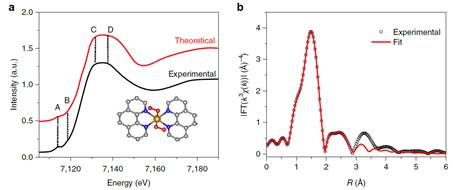| Fe–N–C electrocatalyst with dense active sites and efficient mass transport for high-performance proton exchange membrane fuel cells |
| From: PublishDate:2020-07-30 Hits: |
Proton exchange membrane fuel cell (PEMFC) is a promising sustainable energy conversion device that can efficiently convert chemical energy stored in fuel into electricity, however its commercial application is limited by the high-cost Pt-based precious metal catalyst. Therefore, the development of low-cost, high-performance Pt-free catalysts is a research hotspot in the field of electrocatalysis. Professor Jianglan Shui’s research team at Beihang University designed a highly active Fe–N–C single-atom catalyst, which for the first time reached US Department of Energy (US DOE) 2018 activity target set for Pt-free catalysts. Their research has been published in Nature Catalysis on March 4th, 2019. Through long-term exploration, this research team realized that the low active-site utilization of Fe–N–C catalysts was the main bottleneck in the fuel cell performance, while the pore structure of the catalyst was the key factor that affects their utilizations. They designed and prepared a concave Fe–N–C single-atom catalyst with a large external surface area. The catalyst not only possessed a high Fe–N4 site density, but also had significantly improved active-site utilization in fuel cell relative to traditional catalysts. Thanks to the above advantages, the catalyst exhibited unprecedented hydrogen/oxygen fuel cell performance: 47 mA cm-2@0.88 ViR-free, reaching the DOE 2018 target for Pt-free catalysts; the current density at 0.9 ViR-free was 22 mA cm-2 and the peak power density was 1.18 W cm-2, which were the highest values reported so far.
Figure: The atomic structure of the active sites obtained by XAFS carried out at 1W1B-XAFS station of Beijing Synchrotron Radiation Facility (BSRF). (a) By comparing the XANES experimental spectrum and the theoretical calculation spectra, the most probable atomic structure model (inset) is obtained. (B) EXAFS fitting results. In this work, the researchers relied on the BSRF 1W1B-XAFS station to study the atomic structure of the active sites. X-ray near-edge absorption fine structure (XANES) simulations revealed that the active site had a unique atomically dispersed FeN4C8 structure with two O2 molecules adsorbed in end-on mode. The unambiguous identification of the active site provided a strong support for further research on the structure-performance relationship. This study showed that the active site density was the predominant factor determining the Fe–N–C fuel cell current density, while the large external surface area played crucial roles in maximizing active site density and enhancing the mass transport of the catalyst layer. This work clarified the performance enhancement mechanism of Pt-free catalysts, designed effective catalyst configurations, and provided guidance for the future development of high-performance Pt-free catalysts. Article: Xin Wan, Xiaofang Liu, Yongcheng Li, Ronghai Yu, Lirong Zheng, Wensheng Yan, Hui Wang, Ming Xu* and Jianglan Shui* Fe–N–C electrocatalyst with dense active sites and efficient mass transport for high-performance proton exchange membrane fuel cells. Nature Catalysis 2 (2019) 259–268. |
|
|
| Chinese
- Metal-free efficient photocatalyst for stable visible water splitting——Top ten major scientific progresses in China in 2015
- The nano-resolution imaging platform was awarded the first rate prize of Beijing Science and Technology in 2014
- Beamline 1W1 of BSRF started to runoperate in the couplingparasitic mode of BEPCII
- Synthesis of High Performance Polymer Materials for Field Effect-Transistors
- Surfactant molecular aggregates in green solvents
- GIXRD has played an important role in the characterization of organic thin-film transistors
Science Highlights
Home /
Copyright © 2011 - 2012 Beijing Synchrotron Radiation Facility


